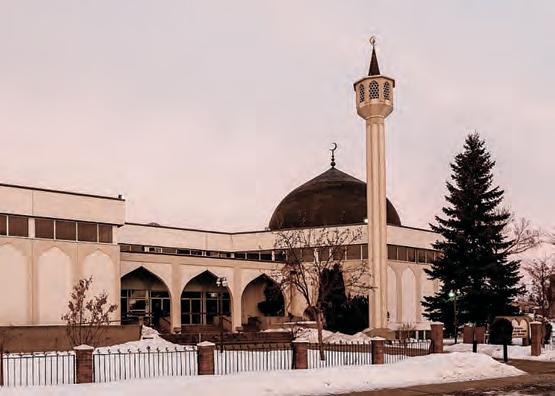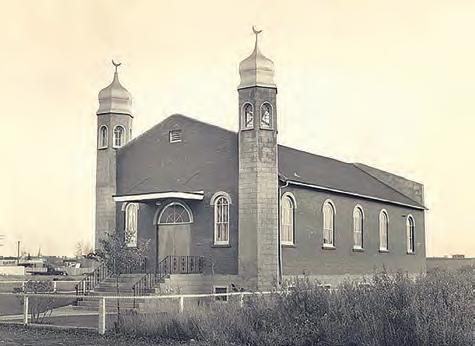
8 minute read
The Al Rashid Mosque
standing out in any way. Personal discrimination, which has few boundaries and is frequently institutional in form, many times leads to an identity conflict.
Canada, a primarily secular nation, developed its policies and structures within that framework. Daood Hamdani (d. 2019), who worked as an economist with the federal government and authored several articles on the country’s Muslim community, stated the main reason for institutional discrimination: “Canadian society was organized for a Christian community, which leaves it unequipped to deal with Islamic tradition.” And yet Canada has much to offer its Muslims and may even help them maintain their identity through the religious freedom that its Charter of Rights provides.
Advertisement
The extent to which each individual feels the link with his/her religious identity depends upon the individual. For a committed Muslim, observing Islam’s ritual practices are the most significant element of his/her Islamic identity. Others believe that praying and reciting the Qur’an are the primary rituals that bring them closer to God. They are not just routines, but the means to achieve wholeness.
Community rituals and gatherings are another mechanism for maintaining identity, for they allow Muslims to relate to each other by reenacting the same ritual and thus sharing something that is uniquely theirs. Accordingly, such rituals strengthen their identity as a distinct group.
Commitment to religious belief is one of the strongest elements that helps preserves an Islamic identity. Generally, Muslims have a strong emotional attachment to their religion and thus attempt to stay true to it in body, mind and spirit. Rather than implying “perfect” adherence, this implies that strong commitment creates a strong consistency between belief and practice, as well as a resultant strengthening of one’s identity. Weak commitment and religious belief often alienate one from his/her identity.
On the personal level, a committed Muslim keeps his/ her links with Islamic practice by observing Islam’s rules in all aspects of life. This type of commitment drives an individual’s behavior and keeps it relatively predictable. For instance, avoiding all types of alcohol because it is prohibited becomes a predictable element in one’s life and a source of stability.
Sometimes, committed Muslims experience a conflict between Canada’s commitment to pluralism and their own sense of special identity. Therefore, the Muslim community acts as a central base where Islam’s values and norms come together. Committing to Islam’s social community reinforces a Muslim’s identification with his/her fundamental roots.
Muslim immigrants find it hard to maintain the “ideal” Islamic identity, for this would require living in an “ideal” Islamic state. Nevertheless, a more “relative” type of Islamic identity can be achieved in the absence of a traditional Islamic state if the political situation allows for it. Such is the case in Canada, where the freedom of religion is a basic right and ethno-cultural plurality is promoted at the national level through the county’s official multicultural policy. ih
Canada’s First Mosque: The Al Rashid Mosque It takes a mosque to build a community
BY NOOR AL-HENEDY
New mosque
Many important features, organizations and landmarks define northeast Edmonton, Alberta. Among the most impressive ones is the Al Rashid Mosque, Canada’s first mosque, which has served Muslims for 80+ years.
In the early 20th century, mainly Arab/Lebanese Muslims flocked to northern Edmonton for its affordable housing and to be near the mosque. The economic boom of the 1970s and an inviting Canadian immigration policy resulted in a rapid Muslim population growth.
The mosque’s visionaries thus purchased a larger lot. However, since most of the Muslims lived in northeastern or northwestern Edmonton, the land was sold and a three-acre lot was purchased for the new Canadian Islamic Center, which included a sizable Al Rashid Mosque.
To understand the mosque’s influence on the community’s development, we consulted Richard A. Awid’s “Canada’s First Mosque: The Al Rashid” (2010). According to him, Muslims of Scottish origin arrived in 1867, followed by Arab Muslims. Many of them settled in Quebec and Ontario and became peddlers who made a living and learned English by selling to local farmers.
Ali Tarrabain, one of Edmonton’s first Arab Muslims, came to Canada in 1901 and by 1906 had moved to northern Edmonton and opened a general store. Shortly thereafter, Ali Hamdon (1907), Ahmed Ali Awid (1928), Najeeb Aiiley (1936) and other Lebanese joined him.
By 1938 the community elders, all of whom were proud of their Canadian identity, began thinking about how to maintain their Arabic culture for their descendants. Until then, they had been praying in each other’s homes. Their solution was Canada’s first mosque — Edmonton’s Al Rashid Mosque.
In September 1938, the Arab Moslem Association (AMA) was incorporated and became the mosque-building project’s executive council in charge. Led by President Joe Teha, Treasurer Nejib Ailey (the mosque’s first religious leader-imam), Secretary Mohammed Assiff and executive
members Milton Saul, Lee Sheddy, pointing to the heavens and declarE.M.M. Hassann and Ali Hamdon, ing God’s oneness with the hand the council forged ahead, right in clutched together. the middle of the Great Depression. Another inspiration was a
On Nov. 24, 1938, Ali Tarrabain famous painting of an old tree stump was the first Muslim to receive a on the shore of Lake Superior, done funeral service at the Al Rashid by the “Group of Seven” — famous Mosque, even before it was comCanadian artists. pleted. Mayor John W. Fry officially Haidar said that he hadn’t opened the mosque on Dec. 11, intended the school’s final appear1938, three weeks after Tarrabain’s ance to resemble the shape of funeral service. Makka’s Grand Mosque. In any case,
The Al Rashid Mosque stood its majestic beauty and architectural proudly on 102 Street and 108 wonder has become a landmark in Avenue site from 1938-1946. In BY 1938 THE COMMUNITY northeastern Edmonton. 1946, the City of Edmonton and the Edmonton Public School ELDERS, ALL OF WHOM WERE THE EDMONTON MUSLIM Board, which wanted the site for PROUD OF THEIR CANADIAN CEMETERY an expanded Victoria Composite High School, negotiated with AMA IDENTITY, BEGAN THINKING Under the leadership of Al Rashid Mosque president Khalid Tarabain, to move it. On Nov. 5, 1946, the ABOUT HOW TO MAINTAIN THEIR the community started thinking mosque was moved to its new location at 102 Street and 111 Avenue. ARABIC CULTURE FOR THEIR about providing its own burial services. He said that this project began
It would be moved once again DESCENDANTS. in 1993 and continues even today, to accommodate the city’s growing as more graves are added when Muslim population. On Aug. 12, needed. They purchased 80 more 1980, the Canadian Islamic Center Believing that an Islamic education acres and developed additional (CIC), which included the mosque, opened program was needed, Mahmoud Ali plots. By 1995, The Islamic Funeral Society its doors at its new northeastern Edmonton Tarrabain, Mickey Jomha, Rony Jomha, was an operational and licensed facility. location on the auspicious day of Eid al-Fitr. Abdul Ghafoor Rana, Dr. Mohamed Shoush And so the CIC and the Al Rashid
The original building, now recognized and Dr. Mohammed Qasqas (the first prinMosque finally completed its vision of as a heritage structure, was moved to Fort cipal) and other local elders opened the providing a mosque, an educational instiEdmonton Park and officially opened on Edmonton Islamic School Society (EISS) tution and funeral and burial services for May 28, 1992, thanks to the efforts of Dr. in the new center’s basement in 1987. the city’s Muslims. The early pioneers have Lila Fahlman and the Canadian Council of A decade later, the K-9 classes had 170 gifted generations of all Edmontonians with Muslim Women (Edmonton Chapter). students. a remarkable legacy. In 2002, a 12.7-acre lot was purchased More importantly, the city’s many young THE EDMONTON ISLAMIC ACADEMY to meet the demand for spaces, In 2006, the Muslim scholars have offered their medIn 1988 the newly formed Edmonton Islamic Edmonton Islamic Academy (EIA), a stateical, legal, education, engineering, archiSchool Society, housed at the Canadian of-the-art facility in all aspects, opened its tectural, artistic, political, business, philIslamic Center and Al Rashid Mosque, doors as Canada’s largest Islamic school. anthropic and many other skills to their opened its first kindergarten class in the Today, it serves 1,400+ K-12 students; an fellow Edmontonians. Many of them are basement. From this humble beginning additional 200+ are on the waiting list. based in northeastern Edmonton, where came the state-of-the-art educational facility The school hall hosts the Friday conthey have indeed shaped a community and located at 127 Street and 145 Avenue. gregational prayers. It’s open to the public affirm the belief that it “takes a mosque to
Under the leadership of Dr. Fahlman, during the evenings and on weekends, and build a community.” Soraya Zaki Hafez and others, the commuits gymnasium and hall are in high demand. To learn more about the remarkable nity lobbied the Edmonton Public School In 2003, Dr. Gulzar Haider (dean of chapter of Canada’s Muslim community, Board (EPSB) for an Arabic-language proarchitecture, Carlton University, Ottawa) please consult Awid, R., Dhaibi, J, Jimale, gram so their children could learn to read was hired to create EIA’s design, an masM., & Jorf. J. 2012. “The Edmonton Islamic the Quran in its original language. EPSB terpiece that comingles Islam’s architectural Academy from Concept to Reality”; Awid, R., saw this as an opportunity to celebrate heritage with Canada’s geographical landHusaini Z., & Tarabain, K. 1999. “Muslims Canada’s multicultural policy within its scape — notably, an iceberg. in Canada”; Tierney, S. 2009. Constitution programs. As a result, in 1982 Edmonton This particular “iceberg’s” features Referendums. The Modern Law Review, became the country’s first city to offer combine the shape of a minaret with that 72(3), 360-383; and Waugh, E. H. 2018. “Al such a program. Today, these programs of an iceberg, as one can see by looking at Rashid Mosque.” ih are offered at six locations, five of them the minaret atop the EIA building. It also Noor Al-Henedy is communications director of Canadian in northeastern Edmonton. symbolizes the right hand’s pointer finger Islamic Centre, Al Rashid Mosque.









